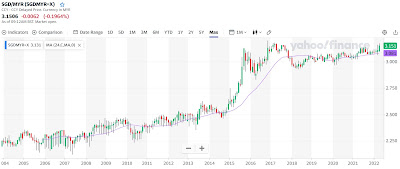Most-Preferred Fiat Currency to Keep my Emergency Funds
The foreign exchange (Forex) market is a global market place for exchanging national currencies. Due to the worldwide reach of trade, commerce, and finance, forex markets tend to be the largest and most liquid asset markets in the world, even larger than the stock market.
Forex is part and parcel of most people's lives. Whenever one is planning for an overseas trip, whether for work or leisure, forex will be considered. Personally, forex is an important part of my life being a Malaysian working in Singapore, especially the US Dollars/Singapore Dollars (USD/SGD) and Singapore Dollars/Malaysia Ringgit (SGD/MYR) currency pairs. USD/SGD is important for me to convert my savings to USD to purchase US shares, while SGD/MYR is important for my to convert a part of my income to pay bills back in Malaysia. Occasionally, other currencies will also be important when there are plans for overseas travel.
About 12 years ago, I like to keep some cash in Australian Dollars (AUD) and even New Zealand Dollars (NZD). This is because at that time, placing a foreign currency fixed deposit in AUD and NZD with Maybank Singapore will yield approximately 4%-8% interest per year! On top of that, the AUD/SGD and NZD/SGD currency pairs were relatively stable around 2010 to 2012. Thus if there was a need to tap into the emergency fund at that time, the cash can be tapped via premature withdrawal from fixed deposit account, missing out only on the interest earned, with minimal effects on exchange rates. Fast-forward to today, if we look at the foreign currency fixed deposit interests in the market, the best rates via Maybank Singapore is for NZD at only 2.05% per annum for 6 months placement. Moreover, with higher volatility between the AUD/SGD and NZD/SGD currency pairs, which is easily affected by commodities, the interests are no longer enticing.
Recently, Jeremy Lefebvre, a Financial Youtuber, spent USD 100K of his emergency funds to buy silver in a bid to fight any possible depreciation in USD. Indeed, since the start of Quantitative Easing (QE) by US Federal Reserve (FED) to print and flood the market with USD to save the economy in 2008/2009, the value of USD has gradually crept downwards, even against SGD. This is further exacerbated with the Covid Crisis in March 2020, which prompted the FED to print trillions of USD to support the economy against the virus. This definitely helped to push the USD lower in value.
With USD, AUD and NZD being in a long term downtrend, it reminded me that my parents like to keep the bulk of their savings mainly in SGD instead of MYR, the main currency they use in my home country. As such, I decided to take a look at how the major currencies perform against the SGD in the past 18 years.
USD/SGD
Based on these two currency pairs, it seems like Singapore Dollars is the best currency to keep my emergency funds, despite the low interest rates in the savings account. To dive deeper, we shall take a look at how SGD compare with other major currencies!
As seen above, apart from Chinese Renminbi/ Yuan (CNY), which is fluctuating between the range of 4.40 to 5.36, all other currencies are showing clear trends of depreciation against the SGD over the 18-year period. This comes as no surprise as there has been mass printing of the Euros and Japanese Yen to prop up the economy (exacerbated by the negative interest rates). Moreover, with the recent flood of CNY by the Chinese government to support their economy, it remains to be seen how the CNY will hold up against SGD.
In conclusion, with low interest rates globally (interest rates are spiking recently but still low from long term perspective), it seems to me that there's no better currencies to keep my emergency fund in the long term apart from the SGD. As such, I will continue to save more in SGD, and slowly allocate more in Singapore dividend shares to combat inflation. At the same time, I will allocate a small amount in USD, to grab any opportunity in near term to buy US shares (which is crashing like there's no tomorrow) because with the hawkish FED, near term USD may continue to appreciate a little against SGD, before continuing its downtrend long term. Meanwhile, Barista FIRE, here I come...!











What about HK$ ? Both have a lot of similarity.
ReplyDeleteI suppose HK$ may follow USD rather closely due to the peg this currency pair is supposed to follow (which suffered a slight de-peg during the 2019 riots if I remember correctly).
Delete